The Complete Guide to Diamond Color Scale
Understanding diamond color charts and color scales
We are reader-supported. Buying through any red colored link on our site may earn us commissions. Learn More.
Understanding diamond color charts and color scales
Diamond color is a crucial aspect of your diamond’s appearance. The color scale ranges from D (completely clear) to Z (warm yellowish tint). While high grades offer little visible difference, they come with a significant price increase. For instance, a D color diamond is stunning, but so is a G color diamond, and you save 30% with the latter. The goal is to find a diamond that appears colorless to the naked eye without breaking the bank.
For high-end colorless diamonds (D-F), you can expect to pay a premium, with prices starting from $6,000 for a 1-carat diamond. On the other hand, near-colorless diamonds (G-J) offer excellent value, with prices for a 1-carat diamond starting around $5,000. Remember, the setting and diamond shape can also influence the perceived color.
In this article, we discuss everything you need to know about diamond color and how to utilize diamonds in the middle of the diamond clarity scale to get the best bang for your buck.
Diamond color refers to how clear a diamond is. The diamond color scale ranges from D (entirely clear) to Z (a yellowish tint). Your intention with color should be to find a diamond that appears colorless. But you don’t need to go to the top of the diamond color scale to accomplish this. Very high grades offer little visible difference but come with a significant increase in diamond price.
What’s the best color for a diamond?
What should I know about the diamond color scale?
What is the GIA diamond color chart?
Does it matter what diamond color I choose for an engagement ring?
FAQs
Our bottom line diamond color recommendations
Why you should trust us
When you’re looking for diamonds to purchase, the diamond color is one aspect of the buying process that you shouldn’t overlook. Diamonds can vary hugely in price based on their color, meaning that picking the right color for your specific needs could help you save a lot of money without affecting the appearance of your fiancé-to-be’s ring.
Distinctly colored diamonds are prized pieces and are available in colors such as blue, pink and yellow. In white diamonds, however, a yellow tint is generally not seen as desirable.
This is because when slight coloring is present, less natural color of the light is reflected back to the eye. The more colorless a diamond is, generally the more radiant, valuable, and rare it is as well.
Colorless diamonds are definitely scarce and rank much higher on the color grading scale than a diamond that has even the softest touch of yellow.
The best diamond color grade is D color. This means the diamond is completely clear with no shade of yellow (or anything else) in it.
The best color for a diamond that you will put in your engagement ring is not D. You can put a G, H or I color diamond in a ring and it will look the same while costing a lot less.
For example, look at this 1 carat, VS2 clarity, excellent cut, D color round brilliant cut diamond from James Allen. There’s no question that its color is fantastic, but it costs $5,300.
Now, look at this H color diamond from James Allen with a similar carat weight that’s identical in clarity and cut quality. While you might be able to notice a very slight difference in color between the two diamonds when they’re viewed under 20x magnification, the color difference is almost imperceptible to the naked eye.
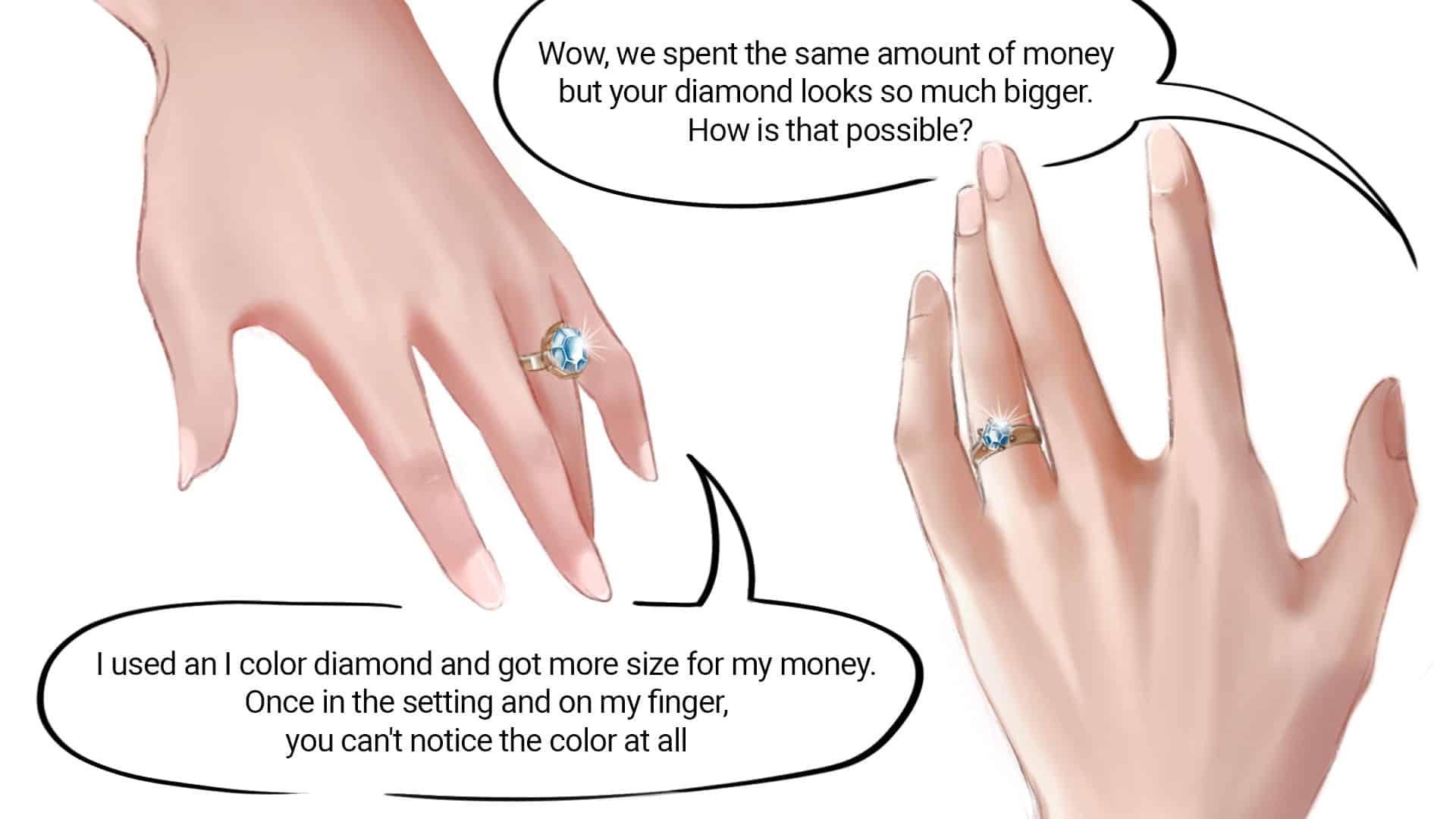
If you choose a yellow or rose gold setting, there’s a good chance that the color of the setting will give the two diamonds an identical appearance anyway, negating the higher color grade.
The difference in price between these two diamonds is $1,670 — money that you could spend on a larger carat weight, a beautiful setting or simply save for your wedding and honeymoon.
On the whole, the best color for a diamond is the color that best fits your personal tastes and preferences, the shape of the diamond, the metal used for the setting and your budget.
Below, we’ve shared our recommendations for diamond color based on the shape of diamond you choose. We’ve also given our expert advice on the color grades that are best suited for each metal, from platinum and white gold to yellow and rose gold.
Pro Tip: When buying a diamond in the IJK range, consider a diamond with medium or strong blue fluorescence. Diamonds with a yellowish tint usually avoid the hazy/cloudy effect seen in colorless diamonds with fluorescence and it tends to brighten up the diamond a bit. Take a look at this J color diamond from James Allen with strong blue fluorescence. It is 18% cheaper than an I color diamond from JA, yet it looks remarkably similar.
Diamond color matters, but only to a certain point. The way we approach the 4Cs, we separate cut and carat weight from color and clarity. Cut and carat are positive traits (you want to maximize as much as possible). Color and clarity are negative traits that you want to make sure you don’t notice when looking at a diamond.
When it comes to color, there is a line on the diamond color scale where you notice whether the diamond is clear or whether it has a yellowish tint. Your goal should be to make sure you don’t buy a diamond with a yellowish tint so low that you notice it. That line between yellowish and clear varies based on the shape of the diamond and the style setting you are putting the diamond in. We get into that below.
Once the diamond looks clear to you, there isn’t much to gain by spending more on higher color. Keep in mind that buying a diamond is a zero-sum game. If you spend more money by going with a higher color grade than necessary, you will have to sacrifice on size, brilliance or clarity. Is it really worth doing that? Take a look at this challenge and decide for yourself.
Before we go further into the specifics of diamond color, let’s cover a few things.
First, you don’t need to be an expert in diamond color to choose a good diamond. While we’ve covered the basics of diamond color below, we’ve also provided our own recommendations, which you can use to limit your search to diamonds of an acceptable color for your preferred shape and setting type.
Second, the difference between one color grade and other grades (for example, a G color diamond and an H color diamond) are very small, so much so that they’re largely impossible to perceive with the naked eye.
However, the difference between one color grade and another that’s three or four above or below it (for example, a G color diamond and a K color diamond) are often easy to see when the diamonds are side by side, especially under bright light and with magnification.
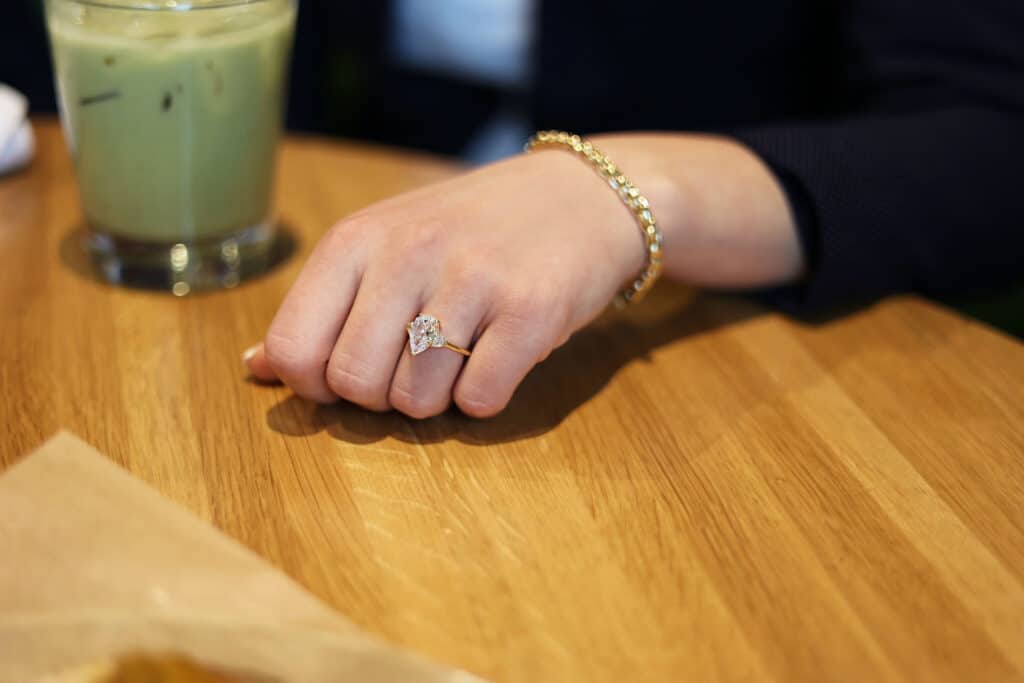
Third, like with everything else related to buying a diamond, there’s no need to choose the best color grade. Unless you have a massive budget, buying a D color diamond is unnecessary when a well-cut G, H or even I color diamond will look just as good once it’s set in a ring and worn on your fiancé-to-be’s finger.
Fourth, a diamond’s shape and the type of metal you choose for the setting both affect which color grade is best. For example, the round brilliant cut is great at hiding color, while the emerald cut isn’t. This means that you’ll need to pick a color grade that’s appropriate for the diamond’s shape.
When it comes to metals, some, such as yellow gold and rose gold, can hide the faint yellow color of a lower-grade diamond better than platinum and white gold.
Just like cut quality, clarity and carat weight, color is one slice of the pie to keep in mind when you’re shopping for a diamond. To get the best value when buying a diamond, it’s important to balance color with the three other Cs.
Diamonds graded from D to F in color are regarded as colorless. The difference between each grade is only something a trained professional will be able to tell, with the use of special equipment.
Colorless diamonds are the highest quality you get on the diamond color scale, containing the faintest trace of color, impossible to notice with the naked eye.

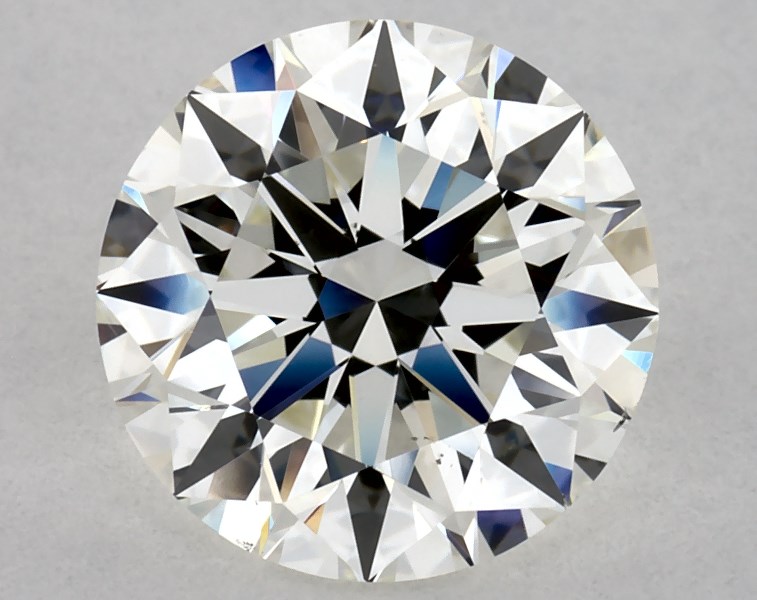

Diamonds with a color grade from G to J are considered “near colorless”. These diamonds’ color may be noticeable if viewed side-by-side with a colorless diamond, but in most cases will appear colorless when viewed on their own.
Diamonds in this grade generally provide the best value, as they are cheaper than colorless diamonds but lack any clear tint that’s noticeable to the naked eye.
Diamond color grades from K to M are regarded as having a “faint” color. With these diamonds, it’s easier to notice a yellowish tint with the naked eye.
For most tastes, there is a clear drop-off in beauty between a near colorless and faintly colored diamond. However, diamonds in this range can offer superior value if placed in a setting that masks color, like one made from yellow or rose gold.
With this out of the way, let’s look at the GIA’s diamond color chart and how it relates to shopping for a diamond.
A diamond color chart shows you the progression of color as you move further down the diamond color scale. Here is a chart that helps you figure out which diamond color is best when purchasing a diamond.
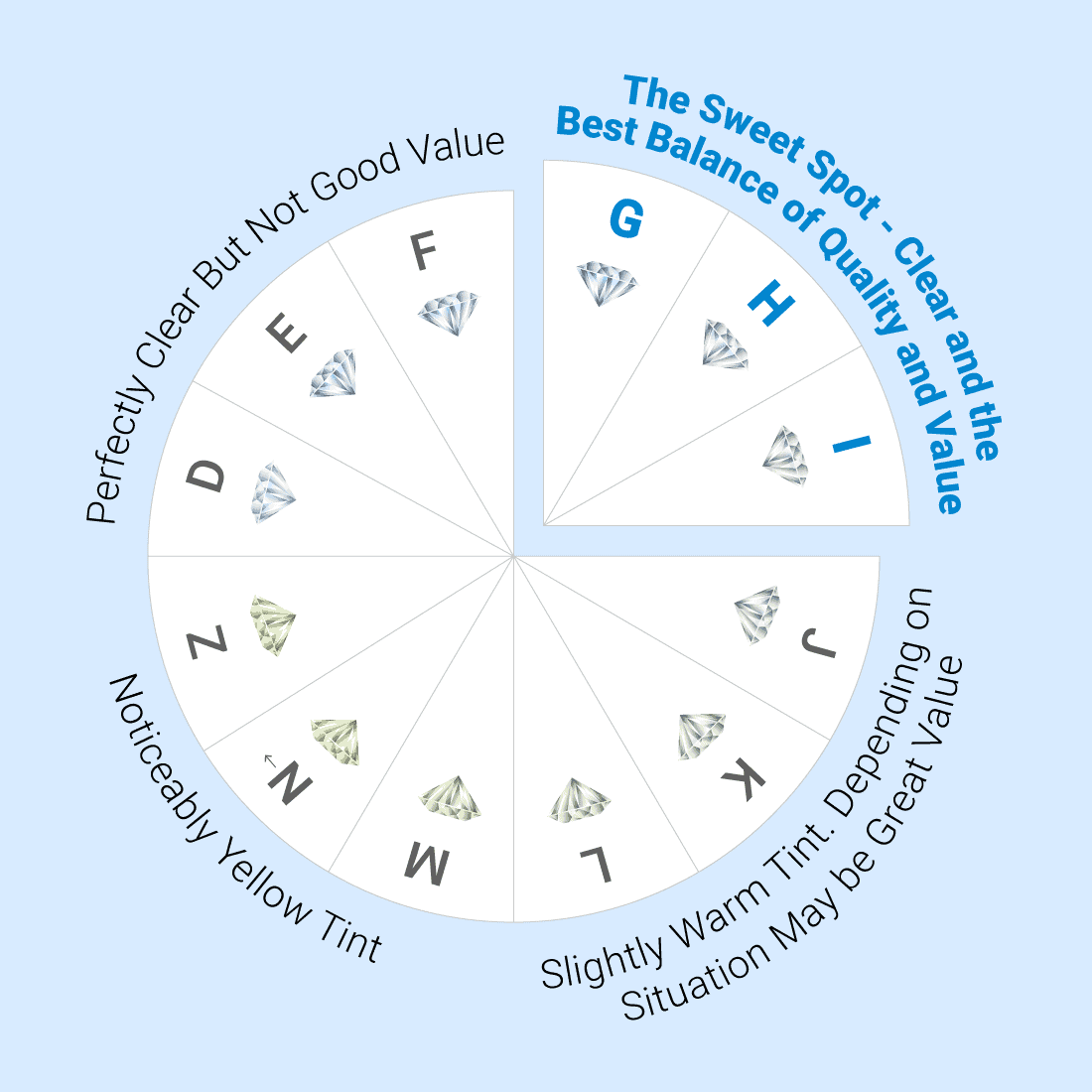
To provide shoppers with an understanding of each diamond’s color level, grading entities like the Gemological Institute Of America (GIA) use a diamond color chart to judge diamonds based on their appearance and give each stone a color grade within a given scale. GIA are the worlds leading experts in certification and have taken the art of color grading to a science.
When you’re in the market for diamonds, it’s advisable to seek a GIA certificate for every diamond you view due to the varying degrees of color that you may come across.
The GIA grades Diamond Color on the following color scale (See here for the GIA’s diamond clarity chart)
| Diamond Color Grade: | Description: |
|---|---|
| D | D is the highest color grade, meaning it has nearly no color. Under magnification and to the naked eye, a D color diamond will appear colorless. D color diamonds are usually set in platinum or white gold, as yellow gold and other jewelry settings detract from the diamond’s uncolored beauty. Diamonds with a D color grade are the most rare and expensive on the market, with a significant price premium over other color grades. |
| E | E color diamonds look almost identical to D color diamonds. Most of the time, the differences in color between a D and E diamond are only visible to an expert gemologist when the two diamonds are viewed under magnification. Like D color diamonds, E color diamonds are usually set in platinum or white gold to avoid the color of the jewelry detracting from their near flawless color. Although these diamonds are less expensive than D color diamonds, they still command a hefty premium. |
| F | F color diamonds are almost identical to D and E color diamonds, with nearly no visible color. Even under magnification and side by side, a D, E and F diamond will look almost identical to anyone other than an expert gemologist. |
| G | G color diamonds exhibit nearly no color and appear primarily colorless to the naked eye. The G color grade is the highest, best grade in the “Near Colorless” range of the GIA’s scale, which covers diamonds graded G to J. Although G color diamonds have some tints of color, they’re almost impossible to detect with the naked eye. Like D-F diamonds, these diamonds should be set in platinum or white gold to reduce any effects of color reflection from yellow or rose gold. |
| H | H color diamonds appear primarily colorless to the naked eye but have a faint yellow hue that’s often visible under magnification in bright lighting, especially when they’re compared to diamonds of a higher color grade. Like G color diamonds, these can be set in platinum or white gold without any issues. H color diamonds are slightly less expensive than G color diamonds and significantly more affordable than diamonds in the colorless range. This is the minimum color grade we recommend for diamond shapes with a large table, such as the radiant and cushion cuts. |
| I | I color diamonds offer a great combination of near colorless looks and good value for money. These diamonds have a slight yellow tint that’s usually only visible when they’re viewed next to diamonds of a higher color grade. An I color round brilliant cut diamond can look fantastic in a platinum or white gold setting, as well as alongside metals such as yellow or rose gold. As you’d expect, I color diamonds are less expensive than G or H color diamonds. This is the minimum color grade we recommend for princess cut diamonds. |
| J | J color diamonds look mostly colorless to the naked eye, but usually have a faint yellow tint that’s easy to notice under bright lights and magnification. In diamonds with a large table, the color might also be visible with the naked eye in certain lighting conditions. From a value for money perspective, J color diamonds can be fantastic choices. We recommend this color for round brilliant cut diamonds set in platinum or white gold (solitaire setting), as the cut of the round diamond is great at concealing color. However, the J color grade is not recommended for diamond shapes with a larger table and fewer facets. |
| K | K color diamonds are classed as “faint tint” on the GIA’s diamond color scale, meaning they have a slight yellow tint that’s visible even to the naked eye. Diamonds in this price range can be found for significantly less than those in the G to J range. Set in a beautiful yellow gold setting, a K color round brilliant cut diamond can look gorgeous. However, diamonds of this color grade should generally not be set in platinum or white gold. |
| L | L color diamonds have a yellow tint that’s visible to the naked eye in normal lighting conditions. Diamonds with this color grade are much more affordable than those in the G to J range, making them a good value for money option. Because of the yellow tint, we don’t recommend the L color grade for non-round diamond shapes. We also don’t recommend it for diamonds set in platinum or white gold. However, L color round brilliant cut diamonds can still look great in yellow gold solitaire rings due to the warm, yellow tone of the metal. |
| M | M color diamonds have a definite yellow tint that’s visible to the naked eye. Like K and L diamonds, M color diamonds offer fantastic value for money when compared to near colorless or colorless diamonds. The M color grade is typically the lowest color grade offered by online diamond vendors. Although M color diamonds can look warm and beautiful in antique yellow gold settings, their color is quite easy to notice even with the naked eye. |
| N-R | Diamonds in the N to R range have noticeable yellow or brown tinting. These diamonds are available at a much lower price point than faintly tinted or near colorless diamonds. We do not recommend diamonds of an N-R grade. |
| S-Z | Diamonds of an S-Z range have easily noticeable yellow or brown tinting. For this reason, We do not recommend S-Z diamonds. |
The diamonds typically used in engagement rings tend to be of the near colorless variety, and you will find that they may contain small hints of yellow or brown in the diamond. The type of setting that is used can also change the perception of the diamond’s color as well as the lighting that the diamond is being shown in as described in the chart above. Keep all of these in mind when looking at the color of the diamonds.
Look at some of the latest rare colorless diamonds sold in auction in 2022.
Color is graded in a different way for fancy color diamonds. While white diamonds receive a grade of D to Z, based on the yellow or brown tint present, fancy color diamonds are graded on the intensity of its color.
Instead of a letter, the grade for fancy color diamonds go from “Faint” to “Fancy Deep.” The color scale is as such:
To use fancy yellow diamonds as an example, a diamond with a “Faint” grade would be slightly more yellow than a Z grade white diamond. While a Fancy Intense or Fancy Vivid yellow diamond has a deep, almost golden hue.
Fancy Vivid, Fancy Deep and Fancy Dark diamonds are equivalent grades, but differ in how bright the color is. Fancy Vivid diamonds have a brighter hue than a Fancy Dark or Fancy Deep.
Fancy Vivid or Fancy Intense diamonds are often the most sought-after fancy colored diamonds, and thus are usually the most expensive, whereas Faint or Light colors are more common and cheaper.
s that are best suited for each metal, from platinum and white gold to yellow and rose gold.
When looking at a range of diamonds, it’s important to pay close attention to a diamond’s coloring. In addition to the GIA Color Grading, be sure to review the diamond yourself or have an expert assist you to give you a better idea of its value instead of relying on your untrained eye.
When examining the diamonds, look for any noticeable tinting and note its interaction with both white light and colored light reflection.
Most importantly, ensure the diamond looks white in relation to its setting. The diamond you’re choosing should stand out as the bright, white focal piece of the jewelry. It is, after all, the most renowned part of the ring.
Based on diverse types of settings, here are our recommendations for diamond color based on diamond shape:
Round: H-J If you choose a grade higher than H, you’ll be paying for a feature you won’t be able to notice or appreciate with the naked eye.
Princess, emerald, asscher: G-I Grades.
All other diamond shapes: F-H Grades.
Round: K-M Grades.
The yellow color of the gold is absorbed into the diamond’s color, so any grade higher than a K will look slightly yellowish anyway.
Princess, emerald, asscher: J-K Grades.
All other diamond shapes: I-J Grades.
Round, princess, emerald and asscher: G-I Grades.
All other diamond shapes: F-H Grades.
All diamond shapes for halo: F-H Grades.
Let’s take a closer look by examining the two diamond color charts below. The same nine diamonds are displayed on the right side and the left side of the chart. On the right, the nine diamonds are face down and arranged in order by color. On the left, the order has been randomized.
By looking at the pictures on the left, are you able to place them in the correct grading order?
(Answer (on the left side) – First Row: G, L, E. Second Row: F, J, D. Third Row: H, K, I.)
As you may have noticed, it’s difficult for the eye to pick up on any one particular element of a diamond.
A diamond is an organic whole. Diamonds were formed from carbon hundreds of feet below the earth’s surface, and the carbon that formed the diamonds was also subjected to intense pressure and heat. This pressure and heat subsequently caused crystallization.
The 4 C’s (cut, color, clarity and carat weight) combine to determine the beauty and brilliance of the diamond. For this reason, the naked eye will have a challenging time differentiating between just one aspect such as the color or the clarity of the diamonds (find out which one is more important – diamond color vs clarity).
Therefore, instead of focusing on one element such as color, it’s better to judge a diamond’s beauty as a whole.
The type of setting you choose can either mask or enhance the color of a diamond. For example, even white gold or platinum engagement ring settings can mask the diamond’s color somewhat.
From this example, we can see just how slight the variations are between the color grades of D and J on a round brilliant diamond. Especially for rounds, but also for other shapes, color is a primarily relative characteristic.
In other words, an I-colored diamond truly only looks like an I-color when it’s placed next to a higher-colored diamond for comparison. In fact, comparison between two diamonds is how even expert diamond dealers and gemologists grade color. They place the diamond to be graded on a white folded card next to a master diamond to compare and determine the color.
Even for diamond experts, it’s difficult to assess a diamond’s color simply by looking at the diamond in question. Unless your loved one will be carrying around a set of GIA color samples to constantly compare their ring to, then you should worry little about color.
Color grade does become relevant, though, if you’re purchasing an engagement ring with side diamonds, or perhaps a three stone ring. We recommend that side (or accent) diamonds always either match the color grade of the center stone, or are slightly darker to accent the higher color grade of the center stone.
If you’re buying a classic solitaire engagement ring setting with no accent diamonds, use your budget in areas other than color to avoid spending on a feature that you won’t derive benefit or beauty from.
At the bottom you’re presented with diamonds from D to K viewed on their side (the way graders grade color) and at the top you have a pool of those 8 diamonds but viewed face-up. Go ahead and try to match them up and see how well you can tell different color grades apart!
Are you considering paying more for a higher color diamond? Let's see if you can even tell the difference between these real diamond images of different colors!
Play GameDrag and drop to match the colors. Score: 36
Do you have any unanswered questions about diamonds? <Click here> to ask.
Invite your friends to beat your score:
Share on FacebookG, H and I color grades give the best value when purchasing a diamond. With these grades, you can get a diamond that appears colorless when set in a ring and observed under normal viewing conditions. Higher grades come with a much higher price, but no noticeable difference in quality.
The most commonly purchased diamonds are those that are near-colorless, often with a faint yellowish tint, falling around the G to J range in color. These are more common than completely colorless diamonds, yet in most cases appear white or clear to the naked eye.
Colorless diamonds are the best at reflecting light and giving off the classic fire and brilliance you expect from a diamond. The best color grade for this is D color, but in reality anything from D through to I color should reflect light perfectly fine.
The “best” diamond color grade (for “white” or colorless diamonds) is a D grade. This is the top of the diamond color scale, indicating the diamond is completely colorless, even when viewed under intense magnification.
Searching for the perfect diamond is all about finding the elements that most heavily influence the diamond’s beauty and brilliance.
In general, color isn’t the most important factor in a diamond. Choose the specific diamond shape you want first, then make sure you’re getting the best cut quality, as this will affect how brilliant the diamond looks once it’s set in a ring. Then, use the information above to choose the right color.
As long as you follow our guidelines below, there is no reason to overpay for color. Take a look at this I color diamond from Blue Nile compared to this G color. Once mounted, these diamonds will look identical color-wise. Without sacrificing any visual quality, you’re saving over 35% on the diamond.
The trick is to make sure the diamond looks white in relation to the setting. Here is a stunning K color round diamond in a yellow gold solitaire setting from Blue Nile. Likewise, here is a beautiful J color diamond from Blue Nile in a rose gold solitaire setting.
Normally a J or K color could have a yellowish tint. However, since it’s contrasted to something darker (the yellow or rose gold) it appears clear and vibrant. On the other hand, here is a similar K color diamond in a halo setting from James Allen. As you can see, the result is underwhelming.
In one case, the K graded colored diamond gives you fantastic value (allowing you to get a larger diamond for your budget with no negative impact on the diamond’s appearance). In the other instance, the result is an undesirable ring that will leave you disappointed.
Still not sure which color to choose? If you want to make sure you’re navigating the diamond buying minefield properly, feel free to contact us for personal help. Our experts are here to do all of the heavy lifting and bring you only the very best diamonds to choose from.
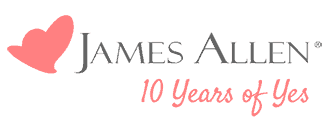



Before you buy a diamond, get personal buying advice from industry veterans. We'll help you get the best diamond for the money.
DISCLAIMER: We don't use your email for marketing. Period.
A diamonds’ price is determined primarily by the 4 Cs of the diamond. On the wholesale level, diamond prices are first based on a diamond shape and
Buying an engagement ring is often one of the first major purchases in a person's life. The process can be fraught with tension as there are so m
A wide range of 1 carat diamonds exist both in online markets and local diamond jewelry stores. Not only are there significant differences in beauty
Please enter your email address to receive your 25% off coupon code:
Here is your coupon code: GFDSF3GF
Comments
DW
December 12, 2023
Reply:
Mike Fried
December 13, 2023
PB
December 21, 2023
Reply:
Mike Fried
December 22, 2023
LT
January 2, 2024
Reply:
Mike Fried
January 3, 2024